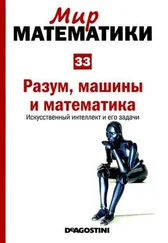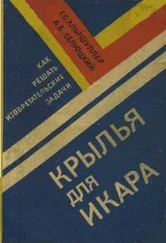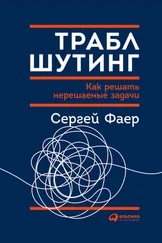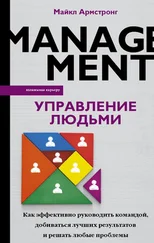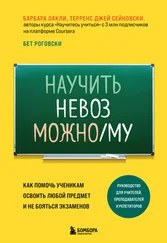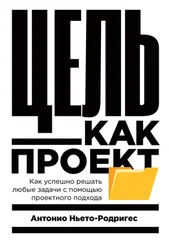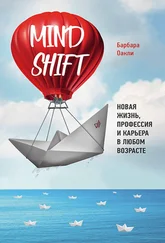Барбара Оакли - Думай как математик - Как решать любые задачи быстрее и эффективнее
Здесь есть возможность читать онлайн «Барбара Оакли - Думай как математик - Как решать любые задачи быстрее и эффективнее» — ознакомительный отрывок электронной книги совершенно бесплатно, а после прочтения отрывка купить полную версию. В некоторых случаях можно слушать аудио, скачать через торрент в формате fb2 и присутствует краткое содержание. Год выпуска: 2012, Жанр: Прочее, на русском языке. Описание произведения, (предисловие) а так же отзывы посетителей доступны на портале библиотеки ЛибКат.
- Название:Думай как математик: Как решать любые задачи быстрее и эффективнее
- Автор:
- Жанр:
- Год:2012
- ISBN:нет данных
- Рейтинг книги:4.67 / 5. Голосов: 3
-
Избранное:Добавить в избранное
- Отзывы:
-
Ваша оценка:
- 100
- 1
- 2
- 3
- 4
- 5
Думай как математик: Как решать любые задачи быстрее и эффективнее: краткое содержание, описание и аннотация
Предлагаем к чтению аннотацию, описание, краткое содержание или предисловие (зависит от того, что написал сам автор книги «Думай как математик: Как решать любые задачи быстрее и эффективнее»). Если вы не нашли необходимую информацию о книге — напишите в комментариях, мы постараемся отыскать её.
Думай как математик: Как решать любые задачи быстрее и эффективнее — читать онлайн ознакомительный отрывок
Ниже представлен текст книги, разбитый по страницам. Система сохранения места последней прочитанной страницы, позволяет с удобством читать онлайн бесплатно книгу «Думай как математик: Как решать любые задачи быстрее и эффективнее», без необходимости каждый раз заново искать на чём Вы остановились. Поставьте закладку, и сможете в любой момент перейти на страницу, на которой закончили чтение.
Интервал:
Закладка:
Drew, C. “Why science majors change their minds (it’s just so darn hard).” New York Times, November 4, 2011.
Duckworth, A. L., and ME Seligman. “Self-discipline outdoes IQ in predicting academic performance of adolescents.” Psychological Science 16, 12 (2005): 939–944.
Dudai, Y. “The neurobiology of consolidations, or, how stable is the engram?” Annual Review of Psychology 55 (2004): 51–86.
Duke, R. A., et al. “It’s not how much; it’s how: Characteristics of practice behavior and retention of performance skills.” Journal of Research in Music Education 56, 4 (2009): 310–321.
Dunlosky, J., et al. “Improving students’ learning with effective learning techniques: Promising directions from cognitive and educational psychology.” Psychological Science in the Public Interest 14, 1 (2013): 4–58.
Dunning, D., et al. “Why people fail to recognize their own incompetence.” Current Directions in Psychological Science 12, 3 (2003): 83–87.
Edelman, S. Change Your Thinking with CBT. New York: Ebury, 2012.
Efron, R. The Decline and Fall of Hemispheric Specialization. Hillsdale, NJ: Erlbaum, 1990.
Ehrlinger, J., et al. “Why the unskilled are unaware: Further explorations of (absent) self-insight among the incompetent.” Organizational Behavior and Human Decision Processes 105, 1 (2008): 98–121.
Eisenberger, R. “Learned industriousness.” Psychological Review 99, 2 (1992): 248.
Ellenbogen, J. M., et al. “Human relational memory requires time and sleep.” PNAS 104, 18 (2007): 7723–7728.
Ellis, A. P., et al. “Team learning: Collectively connecting the dots.” Journal of Applied Psychology 88, 5 (2003): 821.
Elo, A. E. The Rating of Chessplayers, Past and Present. London: Batsford, 1978.
Emsley, J. The Elements of Murder. New York: Oxford University Press, 2005.
Ericsson, K. A. Development of Professional Expertise. New York: Cambridge University Press, 2009.
Ericsson, K. A., et al. “The making of an expert.” Harvard Business Review 85, 7/8 (2007): 114.
Erlacher, D., and M. Schredl. “Practicing a motor task in a lucid dream enhances subsequent performance: A pilot study.” The Sport Psychologist 24, 2 (2010): 157–167.
Fauconnier, G., and M. Turner. The Way We Think. New York: Basic Books, 2002.
Felder, R. M. “Memo to students who have been disappointed with their test grades.” Chemical Engineering Education 33, 2 (1999): 136–137.
Felder, R. M. “Impostors everywhere.” Chemical Engineering Education 22, 4 (1988): 168–169.
Felder, R. M., et al. “A longitudinal study of engineering student performance and retention. V. Comparisons with traditionally-taught students.” Journal of Engineering Education 87, 4 (1998): 469–480.
Fields, R. D. “White matter in learning, cognition and psychiatric disorders.” Trends in Neurosciences 31, 7 (2008): 361–370.
Fischer, K. W., and T. R. Bidell. “Dynamic development of action, thought, and emotion.” In Theoretical Models of Human Development: Handbook of Child Psychology, edited by W. Damon and R. M. Lerner. New York: Wiley, 2006: 313–399.
Foerde, K., et al. “Modulation of competing memory systems by distraction.” Proceedings of the National Academy of the Sciences 103, 31 (2006): 11778–11783.
Gabora, L., and A. Ranjan. “How insight emerges in a distributed, content-addressable memory.” In Neuroscience of Creativity, edited by O. Vartanian et al. Cambridge, MA: MIT Press, 2013: 19–43.
Gainotti, G. “Unconscious processing of emotions and the right hemisphere.” Neuropsychologia 50, 2 (2012): 205–218.
Gazzaniga, M. S. “Cerebral specialization and interhemispheric communication: Does the corpus callosum enable the human condition?” Brain 123, 7 (2000): 1293–1326.
Gazzaniga, M. S., et al. “Collaboration between the hemispheres of a callosotomy patient: Emerging right hemisphere speech and the left hemisphere interpreter.” Brain 119, 4 (1996): 1255–1262.
Geary, D. C. The Origin of Mind. Washington, DC: American Psychological Association, 2005.
Geary, D. C. “Primal brain in the modern classroom.” Scientific American Mind 22, 4 (2011): 44–49.
Geary, D. C., et al. “Task Group Reports of the National Mathematics Advisory Panel; Chapter 4: Report of the Task Group on Learning Processes.” 2008. http://www2.ed.gov/about/bdscomm/list/mathpanel/report/learning-processes.pdf
Gentner, D., and M. Jeziorski. “The shift from metaphor to analogy in western science.” In Metaphor and Thought, edited by A. Ortony, 447–480. Cambridge, UK: Cambridge University Press, 1993.
Gerardi, K., et al. “Numerical ability predicts mortgage default.” Proceedings of the National Academy of Sciences 110, 28 (2013): 11267–11271.
Giedd, J. N. “Structural magnetic resonance imaging of the adolescent brain.” Annals of the New York Academy of Sciences 1021, 1 (2004): 77–85.
Gleick, J. Genius. New York: Pantheon Books, 1992.
Gobet, F. “Chunking models of expertise: Implications for education.” Applied Cognitive Psychology 19, 2 (2005): 183–204.
Gobet, F., et al. “Chunking mechanisms in human learning.” Trends in Cognitive Sciences 5, 6 (2001): 236–243.
Gobet, F., and H. A. Simon. “Five seconds or sixty? Presentation time in expert memory.” Cognitive Science 24, 4 (2000): 651–682.
Graham, P. “Good and bad procrastination.” 2005. http://paulgraham.com/procrastination.html
Granovetter, M. “The strength of weak ties: A network theory revisited.” Sociological Theory 1, 1 (1983): 201–233.
Granovetter, M. S. “The strength of weak ties.” American Journal of Sociology (1973): 1360–1380.
Gruber, H. E. “On the relation between aha experiences and the construction of ideas.” History of Science Cambridge 19, 1 (1981): 41–59.
Guida, A., et al. “How chunks, long-term working memory and templates offer a cognitive explanation for neuroimaging data on expertise acquisition: A twostage framework.” Brain and Cognition 79, 3 (2012): 221–244.
Gŭntŭrkŭn, O. “Hemispheric asymmetry in the visual system of birds.” In The Asymmetrical Brain, edited by K. Hugdahl and R. J. Davidson, 3–36. Cambridge, MA: MIT Press, 2003.
Hake, R. R. “Interactive-engagement versus traditional methods: A six-thousand-student survey of mechanics test data for introductory physics courses.” American Journal of Physics 66 (1998): 64–74.
Halloun, I. A., and D. Hestenes. “The initial knowledge state of college physics students.” American Journal of Physics 53, 11 (1985): 1043–1055.
Houdé, O. “Consciousness and unconsciousness of logical reasoning errors in the human brain.” Behavioral and Brain Sciences 25, 3 (2002): 341–341.
Houdé, O., and N. Tzourio-Mazoyer. “Neural foundations of logical and mathematical cognition.” Nature Reviews Neuroscience 4, 6 (2003): 507–513.
Immordino-Yang, M. H., et al. “Rest is not idleness: Implications of the brain’s default mode for human development and education.” Perspectives on Psychological Science 7, 4 (2012): 352–364.
James, W. Principles of Psychology. New York: Holt, 1890.
Ji, D., and M. A. Wilson. “Coordinated memory replay in the visual cortex and hippocampus during sleep.” Nature Neuroscience 10, 1 (2006): 100–107.
Jin, X. “Basal ganglia subcircuits distinctively encode the parsing and concatenation of action sequences.” Nature Neuroscience 17 (2014): 423–430.
Johansson, F. The Click Moment. New York: Penguin, 2012.
Kalbfleisch, M. L. “Functional neural anatomy of talent.” The Anatomical Record Part B: The New Anatomist 277, 1 (2004): 21–36.
Kamkwamba, W., and B. Mealer. The Boy Who Harnessed the Wind. New York: Morrow, 2009.
Читать дальшеИнтервал:
Закладка:
Похожие книги на «Думай как математик: Как решать любые задачи быстрее и эффективнее»
Представляем Вашему вниманию похожие книги на «Думай как математик: Как решать любые задачи быстрее и эффективнее» списком для выбора. Мы отобрали схожую по названию и смыслу литературу в надежде предоставить читателям больше вариантов отыскать новые, интересные, ещё непрочитанные произведения.
Обсуждение, отзывы о книге «Думай как математик: Как решать любые задачи быстрее и эффективнее» и просто собственные мнения читателей. Оставьте ваши комментарии, напишите, что Вы думаете о произведении, его смысле или главных героях. Укажите что конкретно понравилось, а что нет, и почему Вы так считаете.


